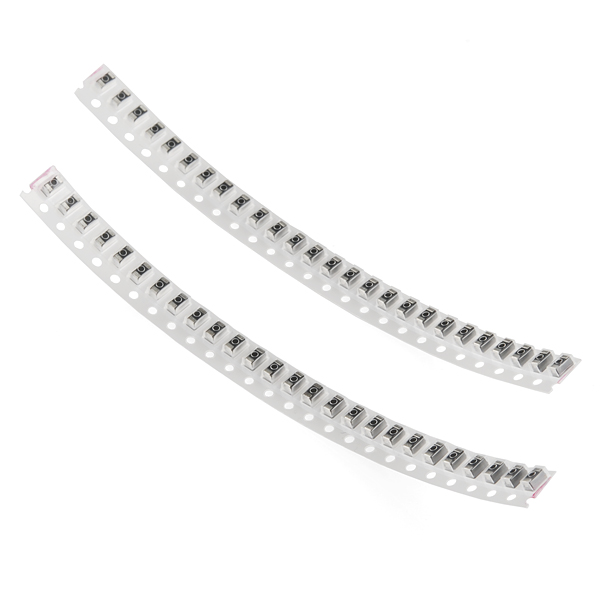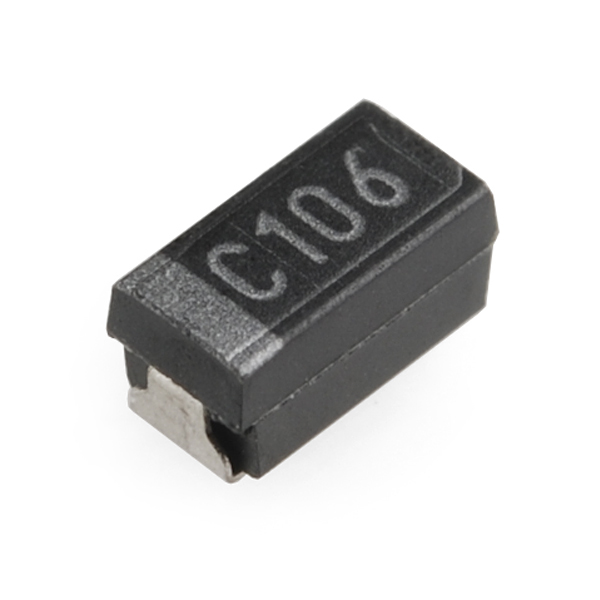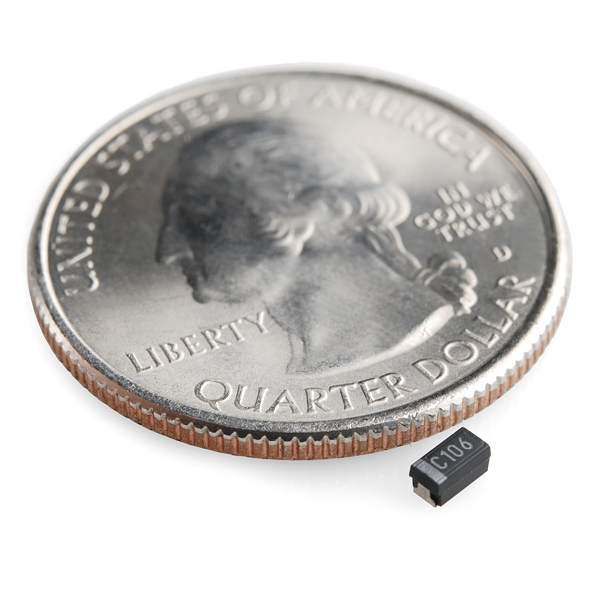Capacitor 10uF SMD (strip of 50)
There are more and more hobbyists taking advantage of surface mount technology these days. With affordable tools like hot air and hotplate reflow ovens, electronics enthusiasts are shrinking their projects down to new levels of portability. Unfortunately, It's not always easy to get your hands on small amounts of SMD parts so here's a strip of common capacitors.
That's right, each pack includes 50 tiny 3216 SMD capacitors in cut-tape packaging.
- 10uF
- Rated at 16V
- +10/-10% Tolerance
Capacitor 10uF SMD (strip of 50) Product Help and Resources
Core Skill: Soldering
This skill defines how difficult the soldering is on a particular product. It might be a couple simple solder joints, or require special reflow tools.
Skill Level: Competent - You will encounter surface mount components and basic SMD soldering techniques are required.
See all skill levels
Core Skill: Electrical Prototyping
If it requires power, you need to know how much, what all the pins do, and how to hook it up. You may need to reference datasheets, schematics, and know the ins and outs of electronics.
Skill Level: Noob - You don't need to reference a datasheet, but you will need to know basic power requirements.
See all skill levels
Comments
Looking for answers to technical questions?
We welcome your comments and suggestions below. However, if you are looking for solutions to technical questions please see our Technical Assistance page.
Customer Reviews
No reviews yet.




After some research on Digikey and Mouser using the 10uF, 3216, 16V, +10/-10% ratings and the black case with 'C106' marking, I'm going to venture a guess that these are Nichion F931C106KAA capacitors (here on Digikey). The datasheet is here, the most important specs not quoted above are:
That 6% dissipation factor seems a little low for typical tantalums. (Perhaps they're at a derated voltage?) I honestly don't know why they give the ESR at 100kHz rather than a frequency graph. For comparison's sake, I grabbed a graph from a higher-quality Vishay part (with a better datasheet). Here's the ESR curve:
which shows that this tantalum has an ESR of about 1 Ω between 100 kHz and 50 MHz.
For a comparison to alternative technologies, I picked this ceramic (part datasheet, series datasheet). It offers:
And here's the ESR curve:
That's 10x better leakage current and 100x lower ESR, not to mention the lower cost! Similar parts are also available in 0805 (metric 2012) packaging, which requires less than half the board area.
Plus, as Whosawhatsis and langwadt opined, ceramics are simply a joy to work with compared to tantalums.
Ten years ago, if you needed a small 10uF tank/decoupling capacitor, it had to be tantalum. Recent advances in ceramic technology have thoroughly changed the landscape. The overwhelming majority of projects will be better served with ceramic (or electrolytic for larger capacitances). There are a few places in which tantalum still makes sense.
The FTDI breakout board, which uses this tantalum part, is not one of those places. Your project is probably not one of those places.
+1 for pictures
Since they didn't mention it, these are tantalum capacitors. The end with the stripe (usually) is the positive side. Also, they must be derated for safety; I wouldn't use a 16V tantalum above 8-12V
You can get 10uF 16V MLCCs (non-polarized ceramic capacitors) in an 0805 package. They're a joy to use compared to tantalums like these.
I agree that MLCCs are a joy to use compared to tantalums. There are many, many reasons why they're better. I've posted a few in this comment below.
yeh, we only use ceramics now they are better in pretty much every respect
tantalum are just too much trouble. The tiniest bit of over voltage, reverse voltage, high current spike or temperature and they short, if that happens on a high current supply they catch fire and/or explode
tantalums are inevitable necessity for use with low cost voltage regulators as bypass capacitors. The regulators which require a bypass capacitor to have a minimum ESR.
Nice idea, but sadly, if I need things in bulk like this I would just go to digikey so I can get SMD ICs and stuff as well. Nothing against you guys, but just pointing it out.
... you may digikey all you want... sparkfun has some of my buisness going their way...
ill place an order as soon as i get a chance...
awesome sparkfun!!!
I think the point is that some hobbyists, even those that know about digikey and friends, have trouble picking the right parts. Digikey is interested in selling you every part, not just the ones that you will find easy to solder. Sparkfun had chosen parts with an easy to use size in common values. Most beginners have no clue about packages, power ratings, voltage ratings, etc.
Ok now that I look at it, these are in a massive package size so I guess it makes sense. I'm just used to using 0201, 0402, or 0603. May not make sense if you want a extremely small board, like my specs usually require.
Right. I've seen SparkFun use these specific capacitors on their FTDI breakouts before. That's probably why they are selling these in strips - so many on hand.
The resistors that SparkFun are selling seem to be 603, by the way.
... 100%